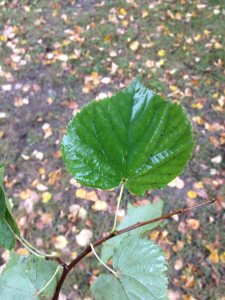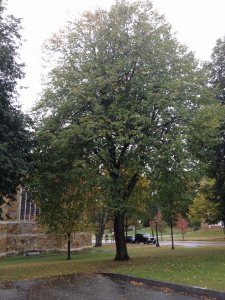Little-leaf Linden
Tilia cordata | Family: Tiliaceae
Submission: Adair Andre ‘18
Leaves – simple, cordate or heart-shaped, with an oblique base and about 1”-3” in size. The leaf surface is glabrous and slightly lustrous above, and glabrous beneath with axillary tufts of brown hairs; color is dark green above and blueish-green beneath; in general, the leaves are very similar to T. americana, but smaller and more finely serrated margins.
Twigs – slender, zigzag, green-brown or red-tinged, particularly in the winter; terminal bud is false, and lateral buds are alternate and plump with one side bulging more; buds are edible and when eaten they are mucilaginous (sticky and gummy).
Fruit – a round, small 4-ribbed nutlet covered with gray-brown pubescence; fruits are in a hanging cluster with a curving, leafy bract acting as a wing on top of the cluster, and they ripen in the fall.
Bark – grey or brown colored and ridged with shallow furrows; young stems are
brown and soon become ridged.
 Natural History:
Natural History:
Little-leaf Linden (Tilia cordata) is in the family Tilaceae and is very similar in appearance to American basswood (T. Americana). The tree size is small-medium and is globose-shaped with an arcing canopy that provides a lot of shade. It is a native European species, but a very common ornamental in the US. Its general range in North America is North-Eastern U.S and Canada. It grows well on fertile, acidic, well-drained loam and clay soils and has low to intermediate tolerance to shade, but grows best in full sun.
Little-leaf Linden began its history in Europe. There is evidence of it having social and cultural significance in Europe beginning around 760 AD. According to the Arbor Day Foundation, in Germanic and Norse lore the tree was favored by the goddesses of love and of the hearth, Freya and Frigga. The tree symbolized fertility, and maidens would often dance around, hug, and hang offerings from its branches. Present day in the US, the tree is a common ornamental in parks and streets due to its medium size, fragrant flowers, and visually appealing symmetric and round arcing canopy which provides significant shade. It is sensitive to road salt though, which can be an issue in urban areas with a lot of snow. It is also used for farmstead windbreaks to prevent intense wind velocities on certain areas.
Little-leaf Linden’s flowers bloom abundantly and are fragrant, appearing in summer after most trees have finished blooming. Hummingbirds and bees are often attracted to the flowers for nectar and pollen. Honey is often harvested and valued.
Little-leaf Linden has various pests, most notably the Japanese beetle (Popillia japonica). This beetle skeletonizes the leaves, eating the tissue between the veins of the leaf. Generally, the tree can survive without insecticide control except for in severe infestations where a mature tree can be completely defoliated. There are some cultivars of Linden being bred that are more resistant to P. japonica.
References:
Arbor Day Foundation. c2015. Little-leaf Linden Tilia cordata. [Nov 5, 2015]. http://www.arborday.org/trees/treeguide/TreeDetail.cfm?ItemID=858
Brockman, C.F. 2001. Trees of North America: A Guide to Field Identification. Revised Edition.Western Pub. Co. Inc. 280pp.
Elias, T.S. 1980. The Complete Trees of North America Field Guide and Natural History. Van Nostrand Reinhold Co., N.Y. 948pp.
Gilman EF, Watson DG. Nov 1993. Tilia cordata: Little-leaf Linden. Environmental Horticulture Department, UF/IFAS Extension. [Feb 2014; Nov 5, 2015]; ENH794
Harlow, W.M., Harrar, E.S., Hardin, J.W. and White, F.M. 1991. Textbook of Dendrology. McGraw-Hill Inc. N.Y. 501pp.
Petrides, G.A. 1972, A Field Guide to Trees and Shrubs. 2nd edition. Houghton Mifflin Co., Boston. 428pp.
Preston, R.J., Jr. 1989. North American Trees. 4th edition. Iowa State Univ. Press. Ames. 407pp.
Sacksteder C J, Gerhold H D. Japanese Beetle Preferences Among Linden Cultivars. School of Forest Resources: The Pennsylvania State University.
Seiler J, Jensen E, Niemiera A, Peterson J. June 2014. Virginia Tech Dendrology Factsheets.
Virginia Tech Dept. of Forest Resources and Environmental Conservation, all rights reserved. [June 2014; Nov. 5, 2015]; Little-leaf linden.
Shane, J. 2004. Dendrology Handbook, University of Vermont, Unpublished.
